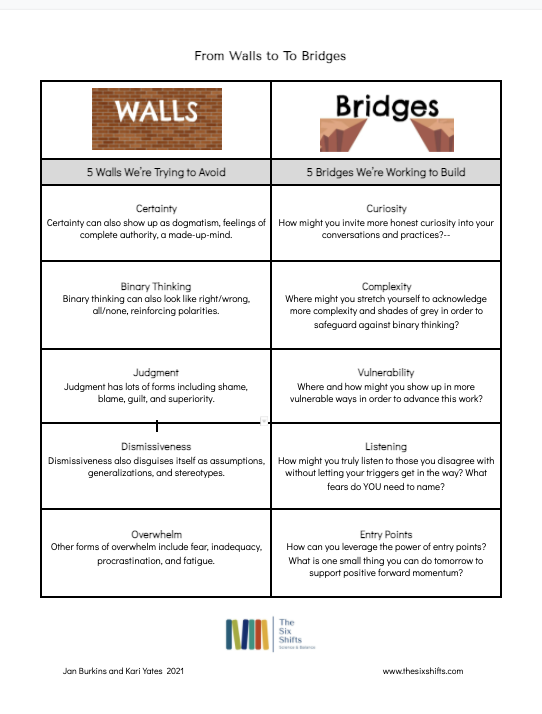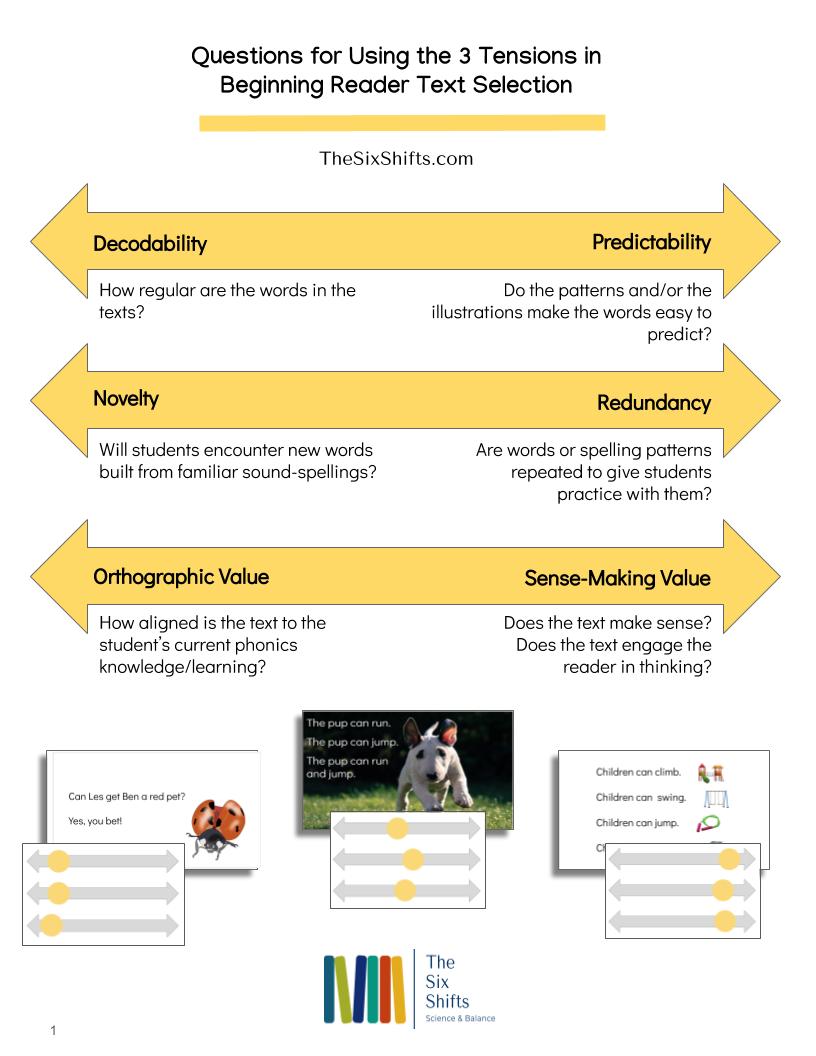The Six Commitments
The work we invite you into is not purely academic or technical in nature. It can also be emotionally taxing work, especially when it calls on us to reevaluate long-held beliefs or practices. As you commit to take an honest second look at practices in your system, school, or classroom – in order to spot misunderstandings, misinformation, and missed opportunities – we hope you will find grace for yourself. To that end, we share with you the commitments we crafted for ourselves as we stepped into this vulnerable work.
The Six Commitments – Printable Color-Me Bookmarks
Would you like to have a fun way to access the Six Commitments or share them with colleagues? These unique printable, “color-me” bookmarks are designed and generously shared by Kim Harkreader. Thanks, Kim! Where might you place these in your world as a reminder to give yourself grace? How will you share these little goodies with those who support and inspire you? Which commitment will you focus on today?
5 Walls and 5 Bridges
Our goal is to create momentum, one conversation and one changed practice at a time. If you’re working to build momentum but running into barriers as people with diverse approaches struggle to hear and understand each other, we invite you to download this tool. In this one-pager we share the five walls we’re trying hard to avoid in our work, and the five bridges we’re working to build.
Dialogic Conversation to Develop Oral Language
Reading comprehension doesn’t start with reading. It starts with oral language comprehension. So, being intentional and strategic about helping young children develop oral language is an essential step toward positioning them for later reading success. Dialogic conversation can serve as a cornerstone to oral language development in the classroom and is described in Chapter 1 of Shifting the Balance, “Rethinking How Reading Comprehension Begins.”
Phonemic Awareness Skills Development Tools
Are you ready for a more intentional approach to phonemic awareness instruction? In this ready-to-use instructional resource, we offer word lists and language prompts to support cohesive phonemic awareness skills development, as described in Chapter 3 of Shifting the Balance. The guide is organized sequentially to align with the skills progression offered in Shifting the Balance, moving from stepping stone skills to the power skills of blending, segmenting, adding, deleting, and substituting/changing phonemes.
Phonemic Awareness Progress Records
This collection of Phonemic Awareness Progress Records includes four different tools to help you gather information about the phonemic awareness development of individual students. The data you collect will help you make intentional decisions about phonemic awareness instruction. The tools can capture data from either informal observation or more formal practice sessions, including individual and group options. We elaborate on these skills and the use of data collection tools for phonemic awareness in our book, Shifting the Balance: 6 Ways to Bring the Science of Reading into the Balanced Literacy Classroom, and in our online class.
Sound-Spellings Chart 1
Sound-Spellings Chart 1 is designed for children in the earliest stages of reading development. It features the most common phonemes for 26 single-letter graphemes, and presents one key word association that demonstrates that spelling. The chart includes short vowel sounds only and intentionally uses key words that are highly decodable for beginning readers. Learn more about teaching sound-spellings in Chapter 3 of Shifting the Balance, “Reimagining the Way We Teach Phonics.”
Sound-Spellings Frieze Cards Set 1
Sound-Spelling Frieze Cards Set 1 features the same 26 consonant and short vowel sounds as the Sound-Spellings Set 1, including the short vowel sounds and highly decodable key words. The frieze cards are in a downloadable, full color PDF ready for printing on 8.5 X 11 paper or card stock. These sound-spellings in full-page format are designed to be read from a distance when displayed in the classroom or used in instruction. Learn more about teaching sound-spellings in Chapter 3 of Shifting the Balance, “Reimagining the Way We Teach Phonics.”
Sound Pronunciation Video Set 1: First Sounds
In this video, Set 1: First Sounds, we share pronunciations for the most common sounds for each letter of the alphabet. What’s important about the way the sounds are pronounced in this video is that these pronunciations make it easier, rather than harder, for students to blend sounds together. You will notice that continuous sounds are held out in this video and the extra sounds–which are easy to inadvertently add in the form of a schwa–are eliminated (when possible) or minimized.
Short Vowels, Blends, and Digraphs: Decodable Word Lists and Sentences
In this comprehensive resource, we provide a collection of short vowel word lists to support phonics instruction and ongoing formative assessment. The resource includes lists of simple CVC words for every short vowel sound. It also houses lists of words that combine single syllable short vowel words with consonant blends and consonant digraphs. Finally, each section ends with a collection of decodable sentences that correlate with each skill. You can download the PDF, print the pages front-to-back, three-hole punch, and place in a binder, creating a go-to reference at your fingertips to use in combination with the suggestions in Chapter 3 of Shifting the Balance, “Reimagining the Way We Teach Phonics.”
In this comprehensive resource, we provide a collection of word lists for the most common long vowel spelling patterns to support phonics instruction and ongoing formative assessment. The tool is organized by long vowel sound, and includes word lists for each of the most common spelling patterns for that long sound. Each section also contains a collection of corresponding decodable sentences. We suggest you download the PDF, print the pages front-to-back, three-hole punch, and place in a binder, creating a go-to reference you’ll want to keep close at hand.
Explicit Phonics Lesson Template
Are you looking for support in delivering explicit phonics instruction? We’ve built this planning template for you. When paired with a research-informed plan for which skills will be taught in which order (scope and sequence), this tool can help you design high-quality whole group or small group phonics instruction. The framework flexibly support either two or three days of instruction on a specific focus skill. The download also includes the planning template plus guidance to make planning for each of the components efficient and effective.
100+ Word Chain Lists
We put together this collection of more than 100 word chain lists to help you leverage the power of minimal contrast word comparisons for building phonemic awareness and phonics skills. This ready-to-go collection of word chains is organized by skill progression. Couple them with sound markers, magnetic letters, or white boards to engage students and meet them where they are as readers. In Chapter 3 of Shifting the Balance we share more about how to use word chains like these with beginning readers.
109 Power Words List
Are you wondering which sight words have the most power for young readers? This is a list of the 109 sight words that comprise 50% of the words found in children’s texts. What’s more, the first 13 represent powerful little words that make up 25% of the words in children’s texts. If you’re interested in the science behind teaching sight words, Chapter 4, in Shifting the Balance is dedicated to considering what needs to shift in our high-frequency word instruction.
The “Look Before You Leap” Routine: Paths to Problem-Solving Using V-MS
This tool is designed to help you teach children to use visual information as a starting point for problem-solving words, relying on meaning and structure for cross-checking. This routine promotes orthographic mapping and the accumulation of orthographic knowledge while also supporting reading for meaning. Learn more about this important shift in balanced literacy instruction in chapter 5 of Shifting the Balance, “Reinventing the Ways We Use MSV (3 Cueing Systems).”
V-MS Decoding Analysis Form
We’ve breathed fresh life into a familiar tool, helping you to think deeply about not only if students are using visual information, but how and at what position in the word. For more information about how to make a shift from miscue analysis to decoding analysis, check out Chapter 5 of Shifting the Balance, “Reinventing the Ways We Use MSV (3 Cueing Systems).”
You will notice we have renamed the form DECODING ANALYSIS, rather than MISCUE analysis, to help clarify the idea that ALL errors are essentially decoding errors, and in every error there is an opportunity to ask ourselves, ‘What decoding skills could have helped the child navigate this word?”
Questions for Using the 3 Tensions in Beginning Reader Text Selection
Choosing texts that help children thrive and grow – rather than frustrate and confuse them – is a critically important, yet challenging job for every teacher of beginning readers. In this tool we offer three tensions to regularly consider when choosing texts for the earliest stages of reading. Learn how to use this tool to select beginning reading texts in chapter 6 of Shifting the Balance, “Reconsidering Texts for Beginning Readers.”
Teacher-Friendly Guide to Making Sense of Scientific Research
Are you confused by conflicting studies and research claims? We’ve written this simple guide just for educators like you to help you make better sense of research, avoid confirmation bias, and make sound instructional decisions.
10 Titles We Recommend for Your Science of Reading Journey
Our journey into the science of reading has been informed and enriched by the work of many great thinkers. Here we share ten of our favorite titles as well as brief descriptions of how they might support your learning. This list is just a starting point! There are many more titles you can explore as you begin to explore the ways reading science can support the learning of your students.




















